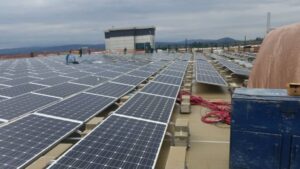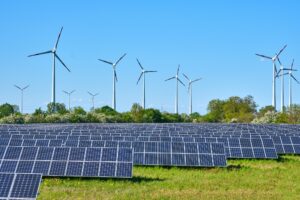It was one of the big themes at the World Energy Future Conference in Abu Dhabi. Solar, and other technologies such as wind power, are no longer more expensive than traditional fossil fuels in many parts of the world. Indeed, they have become cheaper.
The big oil and gas players recognize this. Dr. Adaba Sultan Ahmed al Jabber, the Minister of State of the United Arab Emirates, said at the conference’s opening ceremony that the cost of solar energy was competing with traditional sources of energy. This would not even change with a lower oil price.
He saw this as an opportunity to call for the end of fossil fuel subsidies, which were five times higher than those on renewable energy in 2013. “If we have the courage and opportunity to say yes to thinking differently, this could bring a better future,” he explained. This forward-thinking statement comes from a country which is in the top eight oil producers in the world, and the top seven in natural gas reserves.
A day earlier, the International Renewable Energy Agency (IRENA) predicted that costs for solar energy would fall substantially in the coming years. This would make it even more competitive toward fossil fuels. If government policy makers did not understand this, IRENA said, then they risked making bad decisions about their energy in the future.
Last week, the Saudi Arabian power company ACWE, with some $24 billion in assets, set a world record low for the price of solar in the world’s largest tender. Its CEO, Paddy Padmanathan, told RenewEconomy in an interview that the price of solar will fall by at least a third in coming years. He expects at least half of the 140,000GW of power capacity to be installed in the Middle East and North Africa in the coming decade to be solar.
Padmanathan’s prediction accords with recent statements from Deutsche Bank. They said that solar could strongly extend its reach of within the next two years, assuming a 40% cut in solar costs by the end of 2017. This prediction could come true. Most manufacturers look for way ways to improve efficiency and reduce cost all the time, and the likes of Padmanathan highlight the fall in financing costs.
So, here’s a summary of what Deutsche Bank’s Vishal Shah, one of the leading analysts in the industry, says about the future of solar module costs. Most of it is focused on the rooftop market, but the utility scale should not be forgotten. And, most of the solar energy systems installed in developing countries without grids will be distributed. The big turning point in established energy markets will be the arrival of parity for rooftop installations. (All $ are USD)
The cost of production today
Deutsche Bank notes that total module costs of leading Chinese solar companies have decreased from around $1.31/watt in 2011 to around $0.50/W in 2014. It says this was primarily due to the reduction in processing costs, the fall in polysilicon costs and improvement in conversion efficiencies.
That represents a fall of around 60% in just three years. Deutsche Bank says total costs could fall another 30-40% over the next several years. The greatest cost reductions are likely to come from the residential segments as scale and operating efficiencies improve.
It sees a precedent for this development is the oldest major solar market in the world – Germany. “Costs today are well below costs in the United States and other less mature markets, and total costs have declined around 40% over the last three years. The exact drivers behind lower cost may vary between countries. However, we believe the German example continues to prove that overall system costs will continue to decrease even in comparatively mature markets.”
Total cost reduction will not come from polysilicon
While much of the cost reduction over the last five to ten years has resulted from polysilicon price decrease, future cost reductions will come from non-panel related balance of system costs. Polysilicon’s price used to be the largest cost component in solar panels, and its lower price strongly reduced the cost of solar panels. This changed over the last decade. Today, the price of polysilicon only represents around 10-11 cents/watt. Even if its prices go down more, it will no longer have such a strong effect on the cost of solar panels.
Panels to fall in price to $US0.50/watt
Deutsche Bank says that while trade cases or minimum price agreements could cause issues in the near term, market inefficiencies will be worked out in the long term. Then the clearing price will reach $0.50 or lower within the next several years.
Companies like SunEdison have publicly targeted $0.40 cent/watt panels by the end of 2016, and many leading Chinese manufacturers achieved sub $0.50/w in 2014. Given that most manufacturers are improving by 1-2 cents per quarter, less than ten cents improvement (to reach $0.40) over the next 12 quarters is conservative.
If panels are sold at a 10-cent gross margin for a total cost of $0.50/w, manufacturers would achieve 20% gross margin – well above recent historic averages. Furthermore, transportation costs and ‘soft costs’ which raise the price of panels should gradually improve as governments work through trade issues
Inverter and racking costs are also declining
Inverter prices typically decline 10-15% per year, Deutsche Bank says. It expects this trend to continue into the future. Large solar installers are already achieving $0.25/w or lower on large supply deals, and additional savings will be found over the next several years. Component cost reduction, next generation improvements, and incremental production efficiencies will drive savings on the manufacturing side. Also, new entrants and ongoing price competition will keep margins competitive.
Racking and other balance of system costs are often overlooked as a source of cost reduction. Ongoing efficiency improvements, streamlining, and potential advances in materials can lead to incremental improvements of around $0.25/w to around $0.17/w.
Installation costs will fall by one third in the US
“Cost reduction on the installation side will come primarily from scale benefits, and could fall from $0.65/w to $0.45/w. In fact, solar installation jobs are likely to increase substantially to keep pace with demand. More experienced installers using better tools and techniques on larger systems are likely to more than offset any wage growth through efficiency gains,” Deutsche Bank says.
Sales/Customer acquisition cost will fall even further
The Deutsche Bank sees substantial room for improvement over the longer term in cost/watt terms – from $0.50/w to $0.20/w – as solar gains mainstream acceptance, is recognized as a cost-effective source of electricity and companies develop new/improved methods to interact with customers.
“Already, we are seeing US firms develop automated online systems for customer sourcing. These systems alone should allow further automation as solar begins to ‘sell itself’. Although adoption is still in the early stages in most markets, we think costs could reach the level in the next several years where homeowners begin to recognize the value of generating solar energy themselves.
“We believe this will have two effects: firstly, customers who prefer to own their own systems and have the ability to do so could finance their solar installation through multiple types of loans which are already gaining in popularity. Secondly, customers who focus on the monthly electricity bill will continue to sign PPA’s for solar priced below the retail electricity price curve.
“Furthermore, the wild card for a third prong of the solar explosion lies in the regulatory environment. If utilities begin to offer competitive solar installations regardless of credit quality (under a third-party ownership model), this would open the market to another vast source of potential customers.
Source: http://reneweconomy.com.au/2015/why-solar-costs-will-fall-another-40-in-just-two-years-21235




